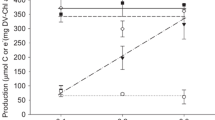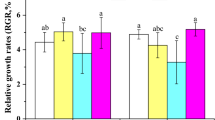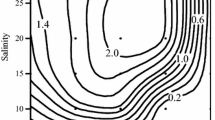Summary
Marine microbial plankton from eastern Canadian Arctic waters have the remarkable ability of rapidly accumulating nutrients (amino acids, glucose, phosphate) at mesobiotic temperatures (≈30°C) after an acclimation period of a few hours. Curves of the nutrient uptake response to temperature established before and after an 8 h acclimation period at 30°C showed that maximum uptake rates attained much higher values and were established at much higher temperatures after the acclimation period. This enhancement was inhibited by chloramphenicol (but not cycloheximide) and occurred even when the possibility of bacterial enhancement due to animal and plant death was reduced by prior removal of organisms using a screen of 1 μm nominal pore diameter. The enhancement at high temperatures was evidenced only in heterotrophic but not in photosynthetic activities and was concominant with large increases in the apparent activity of microbial DNA synthesis and bacterial cell density. The enhancement may have been due to a rapid and opportunistic growth of presumed non-psychrophilic members of the bacterioplankton.
Similar content being viewed by others
References
Allen SD, Brock TD (1968) The adaptation of heterotrophic microcosms to different temperatures. Ecology 49:343–346
Aragno M (1981) Responses of microorganisms to temperature. In: Lange OL, Nobel OS, Osmond CB, Ziegler H (eds) Physiological plant ecology I, encyclopedia of plant physiology, new series, vol 12A. Springer, Berlin Heidelberg New York, pp 339–369
Baross JA, Morita RY (1978) Microbial life at low temperatures: ecological aspects. In: Kushner DJ (ed) Microbial life in extreme environments. Academic Press, London New York, pp 9–71
Buck JD (1979) The plate count in aquatic microbiology. In: Costerton JW, Colwell RR (eds) Native aquatic bacteria: enumeration, activity and ecology, ASTM Special Technical Publ 695. Philadelphia Pa, pp 19–28
Chaloner-Larsson G, Yamazaki H (1977) Adjustment of RNA content during temperature upshift in Escherichia coli. Biochem Biophys Res Commun 77:503–508
Ferroni GD, Kaminski JS (1980) Psychrophiles, psychrotrophs, and mesophiles in an environment which experiences seasonal temperature fluctuations. Can J Microbiol 26:1184–1191
Fuhrman JA, Azam F (1983) Adaptations of bacteria to marine subsurface waters studied by temperature response. Mar Ecol Prog Ser 13:95–98
Gillespie PA, Morita RY, Jones LP (1976) The heterotrophic activity for amino acids, glucose and acetate in Antarctic waters. J Oceanogr Soc Jpn 32:74–82
Gow JA, Mills FHJ (1984) Pragmatic criteria to distinguish psychrophiles and psychrotrophs in ecological systems. Appl Environ Microbiol 47:213–215
Griffiths RP, Hayasaka SS, McNamara TM, Morita RY (1978) Relative microbial activity and bacterial concentrations in water and sediment samples taken in the Beaufort Sea. Can J Microbiol 24:1217–1226
Harder W, Veldkamp H (1971) Competition of marine psychrophilic bacteria at low temperatures. Antonie van Leeuwenhoek; J Microbiol Serol 37:51–63
Harrison WG, Platt T (1983) Photosynthetic characteristics of phytoplankton in the eastern Canadian Arctic. In: Proc IUBS Symp Biol Northern Oceans
Hodson RE, Azam F, Carlucci AF, Fuhrman JA, Karl DM, Holm-Hansen O (1981) Microbial uptake of dissolved organic matter in McMurdo Sound, Antarctica. Mar Biol 61:89–94
Hofle MG (1979) Effects of sudden temperature shifts on pure cultures of four strains of freshwater bacteria. Microbial Ecol 5:17–26
Holm-Hansen O, Azam F, Carlucci AF, Hodson RE, Karl DM (1977) Microbial distribution and activity in and around McMurdo Sound. Antaret J US 12:29–32
Kaneko T, Atlas RM, Krichevsky M (1977) Diversity of bacterial populations in the Beaufort Sea. Nature (London) 270:596–599
Kaneko T, Krichevsky M, Atlas RM (1979) Numerical taxonomy of bacteria from the Beaufort Sea. J Gen Microbiol 110:111–125
Karl DM, Winn CD, Wong DCL (1981) RNA synthesis as a measure of microbial growth in aquatic environments. 1. Evaluation, verification and optimization of methods. Mar Biol 64:1–12
Kornberg HL (1966) Anaplerotic sequences and their role in metabolism. In: Campbell PN, Greville GD (eds) Essays in biochemistry, vol 2. Academic Press, London New York, pp 1–31
Lemaux PG, Herendeen SL, Bloch PL, Neidhardt FC (1978) Transient rates of synthesis of individual polypeptides in E. coli following temperature shifts. Cell 13:427–434
Li WKW (1983) Consideration of errors in estimating kinetic parameters based on Michaelis-Menton formalism in microbial ecology. Limnol Oceanogr 28:185–190
Li WKW (1984) Microbial uptake of radiolabeled substrates: estimates of growth rates from time course measurements. Appl Environ Microbiol 47:184–192
Li WKW, Subba Rao DV, Harrison WG, Smith JC, Cullen JJ, Irwin B, Platt T (1983) Autotrophic picoplankton in the tropical ocean. Science 219:292–295
Li WKW, Smith JC, Platt T (1984) Temperature response of photosynthetic capacity and carboxylase activity in arctic marine phytoplankton. Mar Ecol Prog Ser 17:237–243
Maita Y, Yanada M, Rikuta A (1974) Rates of net assimilation and respiration of amino acids by marine bacteria. J Oceanogr Soc Jpn 30:1–9
McBee RH, McBee VH (1956) The incidence of thermophilic bacteria in arctic soils and waters. J Bacteriol 71:182–185
McDonald JJ, Quadling C, Chambers AK (1963) Proteolytic activity of some cold-tolerant bacteria from Arctic sediments. Can J Microbiol 9:303–315
Morita RY (1975) Psychrophilic bacteria. Bacteriol Rev 39:144–167
Morita RY, Burton SD (1970) Occurrence, possible significance and metabolism of obligate psychrophiles in marine waters. In: Hood DW (ed) Organic matter in natural waters. Inst Mar Sci, Occ Publ No 1. Univ Alaska, College Alaska, pp 275–285
Morita RY, Griffiths RP, Hayasaka SS (1977) Heterotrophic activity of microorganisms in antarctic waters. In: Llano GA (ed) Adaptations within antarctic ecosystems. Gulf Publ, Houston Tex, pp 99–113
Nedwell DB, Floodgate GD (1971) The seasonal selection by temperature of heterotrophic bacteria in an intertidal sediment. Mar Biol 11:306–310
Ng H, Ingraham JL, Marr AG (1962) Damage and derepression in Escherichia coli resulting from growth at low temperatures. J Bacteriol 84:331–339
Oppenheimer CH, Drost-Hansen W (1960) A relationship between multiple temperature optima for biological systems and the properties of water. J Bacteriol 80:21–24
Platt T, Harrison WG, Irwin B, Horne EP, Gallegos CL (1982) Photosynthesis and photoadaption of marine phytoplankton in the Arctic. Deep-Sea Res 29:1159–1170
Porter KG, Feig YS (1980) The use of DAPI for identifying and counting aquatic microflora. Limnol Oceanogr 25:943–948
Robarts RD, Sephton LM (1981) The enumeration of aquatic bacteria using DAPI. J Limnol Soc S Afr 7:72–74
Romanenko VI (1982) Temperature optima of the bacterioplankton in Rybinsk reservoir at different seasons of the year. Microbiology 51:697–701
Ruger H-J (1982) Psychrophilic sediment bacteria in the upwelling area off NW-Africa. Naturwissenschaften 69:448–450
Ryals J, Little R, Bremer H (1982) Control of RNA synthesis in Escherichia coli after a shift to higher temperature. J Bacteriol 151:1425–1432
Sieburth J McN (1964) Polymorphism of a marine bacterium (Arthrobacter) as a function of multiple temperature optima and nutrition. In: Marshall N, Jeffries HP, Napora TA, Sieburth J McN (eds) Experimental marine ecology, Graduate School of Oceangr, Univ Rhode Island, Occ Publ, No. 2. Kingston RI, pp 11–16
Sieburth J McN (1967) Seasonal selection of estuarine bacteria by water temperature. J Exp Mar Biol Ecol 1:98–121
Sieburth J McN, Smetacek V, Lent J (1978) Pelagic ecosystem structure: heterotrophic compartments of the plankton and their relationship to plankton size fractions. Limnol Oceanogr 23:1256–1263
Takahashi M, Ichimura S (1971) Glucose uptake in ocean profiles with special reference to temperature. Mar Biol 11:206–213
Van Es FB, Meyer-Reil L-A (1982) Biomass and metabolic activity of heterotrophic marine bacteria. Adv Microbiol Ecol 6:111–170
Wiebe WJ, Hendricks CW (1974) Distribution of heterotrophic bacteria in a transit of the Antarctic Ocean. In: Colwell RR, Morita RY (eds) Effect of the ocean environment on microbial activities. University Park Press, Baltimore Md, pp 524–535
Wright RT, Hobbie JE (1966) Use of glucose and acetate by bacteria and algae in aquatic ecosystems. Ecology 47:447–453
Yamamori T, Ito K, Nakamura Y, Yura T (1978) Transient regulation of protein synthesis in Escherichia coli upon shift-up of growth temperature. J Bacteriol 134:1133–1140
Zobell CE, Conn JE (1940) Studies on the thermal sensitivity of marine bacteria. J Bacteriol 4:223–238
Author information
Authors and Affiliations
Rights and permissions
About this article
Cite this article
Li, W.K.W., Dickie, P.M. Rapid enhancement of heterotrophic but not photosynthetic activities in Arctic microbial plankton at mesobiotic temperatures. Polar Biol 3, 217–226 (1984). https://doi.org/10.1007/BF00292626
Received:
Accepted:
Issue Date:
DOI: https://doi.org/10.1007/BF00292626




